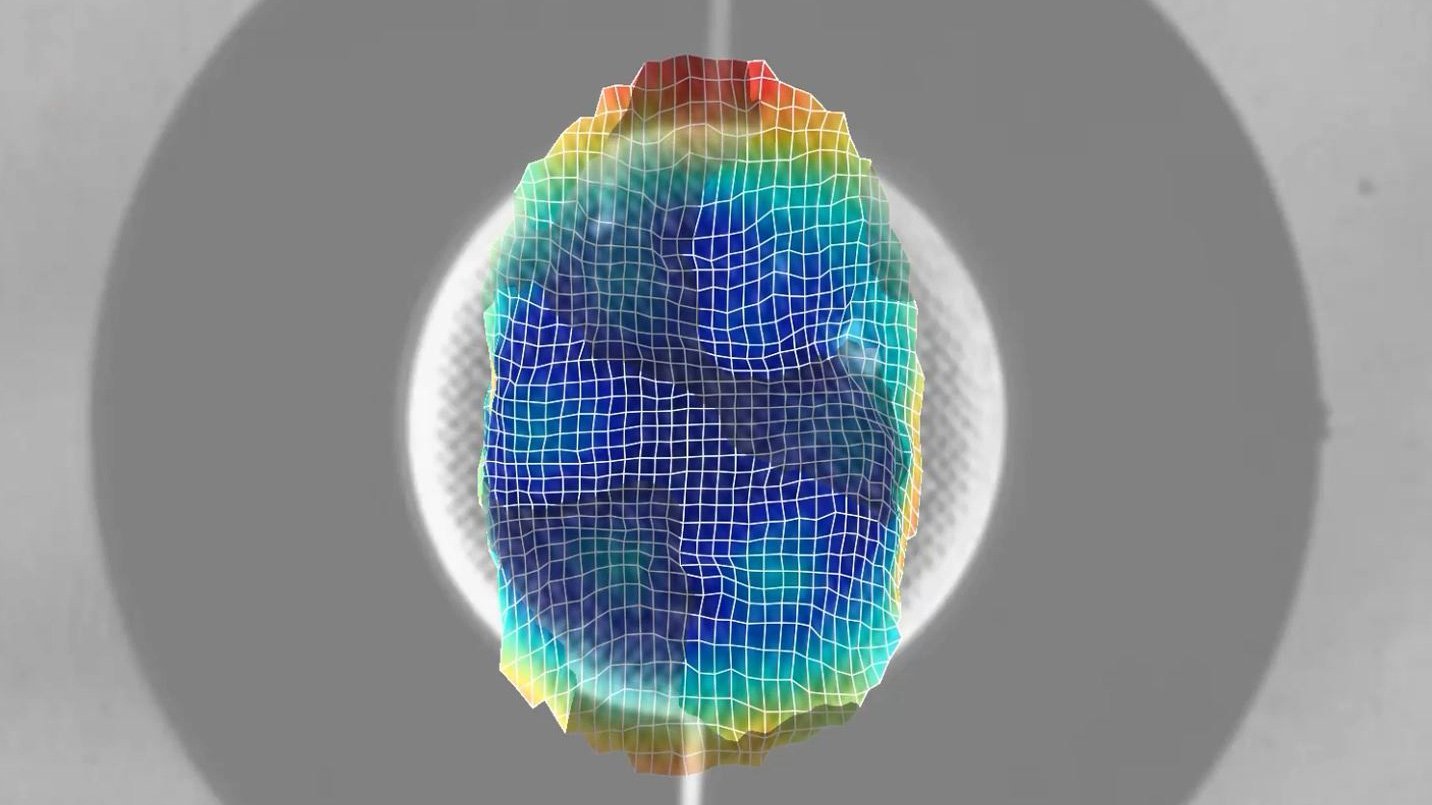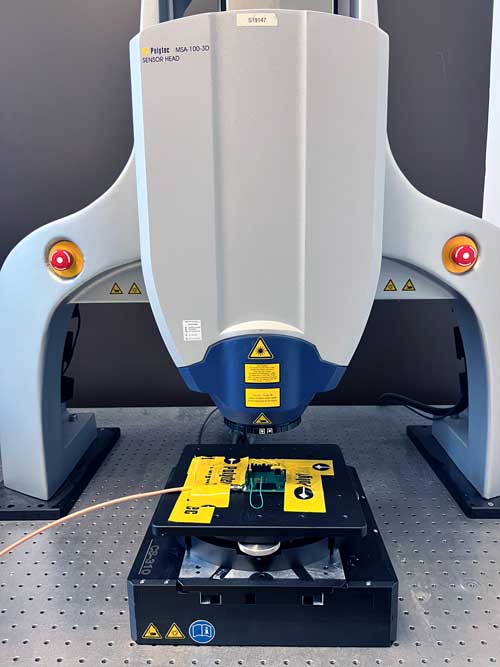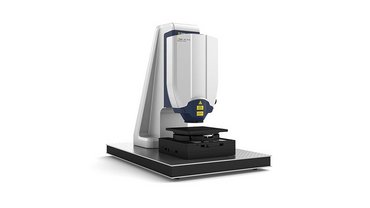
Piezoelectric disk resonators are designed to transduce specific contour mode bulk acoustic wave (BAW) resonant shapes. Utilizing a unique property of lead magnesium niobite-lead titanate (PMN-PT) thin films, microfabricated disk resonators are characterized using laser Doppler vibrometry. PMN-PT is a ferroelectric material that is known for its piezoelectric and electrostrictive properties. In-plane displacement profiles are visualized to show contour mode resonant shapes, tangential and wine glass mode family specifically. These contour mode shapes are of great importance for bio-sensing, RF and rotation sensing applications.
Piezoelectric MEMS devices are ubiquitous in a broad application space ranging from biological sensing to RF filters used in our cellphones. Utilizing resonant behavior of acoustic waves induced by piezoelectricity enables these applications, especially in sensing domain. Bulk acoustic wave (BAW) and surface acoustic wave (SAW) resonators with various geometries have proven to be useful with robust operation and simple microfabrication techniques.
Within the family of BAW resonators, contour modes are especially attractive for applications where multiple modes or frequencies are required on the same die since resonant frequency of devices are defined by lateral geometry of the resonators. Disk resonators yield some of the most interesting mode shapes that are useful in RF filtering, navigation, and bio-sensing applications in particular.
Tangential mode resonance, for instance, is an isochoric mode: meaning the total volume of the resonant body does not change during resonance. This purely shear rotation-like mode shape is used in bio-sensing since it produces displacement that is entirely parallel to the fluid flow. However, it is not possible to transduce this mode shape using direct piezoelectric effect with the conventional piezoelectric materials known.

Another interesting mode shape is wine glass mode resonance where a combination of radial and tangential displacements contributes to the mode shape. Although it is possible to transduce this mode with segmented electrodes (Figure 1) that partially match the strain profile of the disk resonator, unavoidable misalignment problem causes spurious modes to appear.

This study demonstrates that both tangential and wine glass mode family can be transduced directly using a single electrode that spans the entire disk surface, as shown in Figure 2. Thus, the misalignment potential is entirely eliminated while providing efficient coupling to the modes of interest.
Transduction of these modes is made possible utilizing a unique property of lead magnesium niobite-lead titanate (PMN-PT) thin film. A specific cut of this single crystal materials has in-plane piezoelectric coefficients with opposite sign that cause in-plane displacement in opposite directions.

Experimental setup
Microfabricated disk resonators are fixed to a fan-out PCB with electrical connections through wire bonds to connect to Polytec MSA-100-3D. This vibrometer provides vibration information in both inplane and out-of-plane directions. Electrically excited modes are scanned, and mode shapes are analyzed using PSV software.
The PSV software allows for a customized grid of points with variable spatial resolution tailored to the frequency of interest. Disks with radii ranging from 20 µm to 60 µm are scanned using a cartesian grid of datapoints with equal spacing to avoid spatial and geometric biasing and aliasing.
Figure 3 shows the experimental set up. Figure 4 shows the overview of the device and the scan grid. In this particular test, measurements were acquired at 1,085 locations.
To enhance diffused scatter that is required for detection of in-plane displacement, photoresist patterns are incorporated on the top electrode of the disks. Figure 5a shows the disk resonator that was tested, whereas figure 5b shows a closeup with the surface modification to increase backscattered light.


Results
Wine glass mode resonance (8.42 MHz) is characterized to have 11.46 nm tip displacement on a 60 µm radius disk resonator when 1V input voltage amplitude is applied. The same device under 1V excitation exhibits tangential resonance at 282 kHz that results in 40 °/s rotation rate. A linear dependence of the displacement characteristics to the applied voltage is observed for both resonant modes.
Conclusion and outlook
Tangential and wine glass mode shapes are excited using a single electrode because of a unique material property of PMN-PT. The use of single electrode allows self-alignment of the electrode to the resonant body eliminating misalignment problems. Microfabricated disks are characterized using laser Doppler vibrometry demonstrating these contour mode shapes.
The self-aligned feature of this actuator can be attractive for quadrature-error free gyroscopes, tangential-mode TED-free oscillators. The rotation rate values of the tangential mode and its linear dependency on the amplitude of the applied signal indicates that the disk resonator can serve as a micro rate table for in-site scale-factor calibration of gyroscopes. Therefore, this technology provides the key building block for a BAW MEMS gyroscope with a built-in primary calibration stage.
Background information
- Contour mode: Contour modes are typically observed in structures with well-defined geometric shapes where the vibration occurs along the contour or perimeter of the structure. Cylinders, disks, and other curved shapes are more likely to exhibit contour modes because they have continuous curves or contours along which particles can vibrate. The disk resonator discussed here is a structure typical for exhibiting contour modes.
- Electrostriction: In electromagnetism, electrostriction is a property of all electrical non-conductors, or dielectrics, that causes them to change their shape under the application of an electric field. The related piezoelectric effect occurs only in a particular class of dielectrics. Electrostriction applies to all crystal symmetries, while the piezoelectric effect only applies to the 20 piezoelectric point groups. Electrostriction is a quadratic effect, unlike piezoelectricity, which is a linear effect.
- Piezoelectricity: Piezoelectricity is a phenomenon in which certain materials generate an electric charge in response to mechanical stress or pressure, and conversely, they undergo a mechanical deformation when an electric field is applied to them. Piezoelectrics are materials that lack a center of symmetry to the crystallographic unit cell. Therefore, when a stress is applied to the crystal, the ions displace and cause separation of positive and negative charge centers. This enables the material to convert between mechanical energy (stress) and electrical energy (charge), in either direction.
- Ferroelectricity: Ferroelectricity is a property exhibited by certain materials in which they can exhibit a spontaneous electric polarization that can be reversed by applying an external electric field. Ferroelectric materials are a subset of piezoelectric materials.
Images courtesy of the authors unless otherwise specified.


